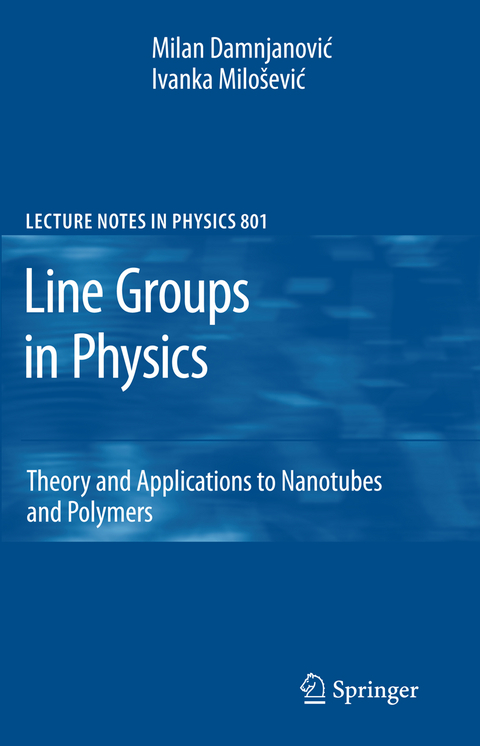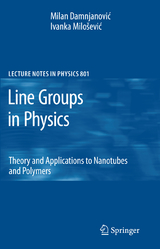Line Groups in Physics
Theory and Applications to Nanotubes and Polymers
Seiten
2010
Springer Berlin (Verlag)
978-3-642-11171-6 (ISBN)
Springer Berlin (Verlag)
978-3-642-11171-6 (ISBN)
This overview of line groups presents the mathematical foundation and classifications of line groups, quasi one-dimensional crystals and quantum numbers. It also contains important applications and extensive illustrations related to the physics of nanotubes.
Over last decades low-dimensional materials are in focus of physics and chemistry as well as of material and other natural sciences. Like Vitaly Ginzburg has foreseen 30 years ago, low dimensionality offers physical phenomena and properties unseen in three-dimensional world. To see how thin ?lms and monomolecular layers realize such a prediction it suf?ces only to observe intensity of research devoted to recently synthesized graphene. Still, quasi-one-dimensional compounds are over long period established as the origin of the most important and most interesting discoveries of material science and solid state physics. To mention only deoxyribonucleic acid, the most important molecule in nature, and diversity of nanotubes and nanowires, the cornerstones of the present and future nanotechnology. Line groups, describing symmetry of quasi-one-dimensional materials, offer the deepest insight to their characteristic properties. Underlying many of the laws, they are very useful, but far from simple. This book is intended to explain them, their properties, and their most common applications. In particular, it is important to understand that the line groups are much wider class of symmetries than the well-known rod groups. While the latter describe only translationally periodical objects, line groups include symmetries of incommensurate periodical structures.
Over last decades low-dimensional materials are in focus of physics and chemistry as well as of material and other natural sciences. Like Vitaly Ginzburg has foreseen 30 years ago, low dimensionality offers physical phenomena and properties unseen in three-dimensional world. To see how thin ?lms and monomolecular layers realize such a prediction it suf?ces only to observe intensity of research devoted to recently synthesized graphene. Still, quasi-one-dimensional compounds are over long period established as the origin of the most important and most interesting discoveries of material science and solid state physics. To mention only deoxyribonucleic acid, the most important molecule in nature, and diversity of nanotubes and nanowires, the cornerstones of the present and future nanotechnology. Line groups, describing symmetry of quasi-one-dimensional materials, offer the deepest insight to their characteristic properties. Underlying many of the laws, they are very useful, but far from simple. This book is intended to explain them, their properties, and their most common applications. In particular, it is important to understand that the line groups are much wider class of symmetries than the well-known rod groups. While the latter describe only translationally periodical objects, line groups include symmetries of incommensurate periodical structures.
Milan M. Damnjanovic Date of birth: 7 Septemer 1953 Citizenship: Serbia Ivanka P. Milosevic Date of birth: 28 December 1962 Citizenship: Serbia
Line Groups Structure.- Symmetrical Compounds.- Irreducible Representations.- Tensors.- Magnetic Line Groups.- Vibrational Analysis.- Applications.- Nanotubes.
From the reviews:
"The key words 'line groups' in the monograph's title point to the coverage of the study, by group theoretical methods, of the symmetry of quasi-one-dimensional physical systems, the structure of which shows two distinct features ... . In view of the huge rise of interest during the last decade in the investigation of such low-dimensional finite 'nano'-systems ... the monograph under review is a timely publication. ... Well-done illustrative color figures help the reader to assimilate the arid evidence collected in the tables." (Gh. Adam, Mathematical Reviews, Issue 2011 f)| Erscheint lt. Verlag | 3.5.2010 |
|---|---|
| Reihe/Serie | Lecture Notes in Physics |
| Zusatzinfo | XII, 200 p. 38 illus. |
| Verlagsort | Berlin |
| Sprache | englisch |
| Maße | 155 x 235 mm |
| Gewicht | 360 g |
| Themenwelt | Naturwissenschaften ► Physik / Astronomie ► Allgemeines / Lexika |
| Naturwissenschaften ► Physik / Astronomie ► Theoretische Physik | |
| Schlagworte | Analysis of Symmetry Properties • Condensed Matter • Group Theory in Condensed Matter • Low Dimensional Crystals • Solid state physics • Symmetry of Nanotubes • Symmetry of Polymers |
| ISBN-10 | 3-642-11171-8 / 3642111718 |
| ISBN-13 | 978-3-642-11171-6 / 9783642111716 |
| Zustand | Neuware |
| Informationen gemäß Produktsicherheitsverordnung (GPSR) | |
| Haben Sie eine Frage zum Produkt? |
Mehr entdecken
aus dem Bereich
aus dem Bereich
für Studierende der Naturwissenschaften und Technik
Buch | Hardcover (2024)
Springer Spektrum (Verlag)
79,99 €
für Studierende der Natur- und Ingenieurwissenschaften
Buch | Hardcover (2023)
Hanser (Verlag)
39,99 €




